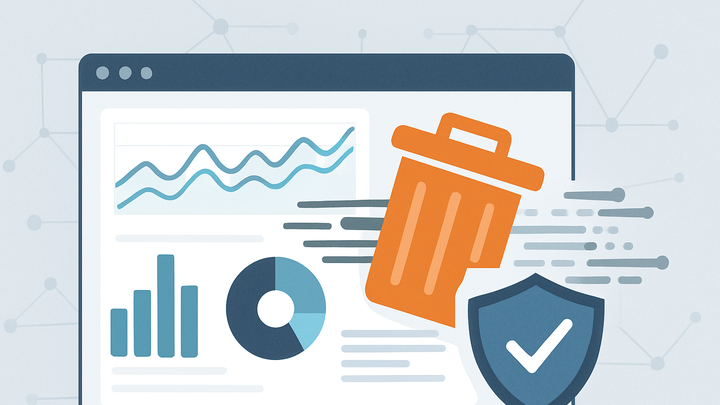Published on 2025-06-28T06:30:39Z
What is Data Deletion in Analytics? Examples & Best Practices
Data Deletion in analytics refers to the process of permanently removing collected data from analytics systems, whether triggered by privacy regulations, internal data retention policies, or user-initiated requests. This practice is crucial for ensuring compliance with laws like the GDPR’s Right to be Forgotten and the CCPA’s deletion requirements, as well as for maintaining data quality by eliminating outdated or irrelevant records. Effective data deletion safeguards user privacy, reduces storage costs, and prevents analysis biases caused by stale or erroneous data. Analytics platforms such as Google Analytics 4 and PlainSignal provide built-in settings and APIs to automate deletion processes, while also allowing for manual or programmatic purges when necessary. Failing to properly delete data can lead to legal penalties, damage to brand reputation, and difficulties in data management and analysis.
Data deletion
The process of permanently removing analytics data to comply with privacy laws, honor user requests, and maintain data quality and storage limits.
Why Data Deletion Matters
In analytics, data deletion ensures that user data is removed when it is no longer needed, supporting privacy, regulatory compliance, and data quality. Failing to delete obsolete or user-requested data can lead to legal penalties, reduced user trust, and bloated datasets that hamper analysis.
-
Regulatory compliance
Complying with laws like GDPR and CCPA requires organizations to honor user requests for deletion and to purge data after retention periods expire.
-
User trust and privacy
By deleting data that users no longer want stored, companies demonstrate respect for privacy, fostering greater trust and transparency.
Key Regulations for Data Deletion
Several privacy frameworks mandate clear policies and technical mechanisms for deleting personal data upon request or after a defined retention period.
-
Gdpr (general data protection regulation)
GDPR Article 17, known as the ‘Right to be Forgotten,’ requires data controllers to erase personal data without undue delay upon user request, subject to certain exceptions.
-
Request handling
Organizations must verify the identity of the requester and process deletion requests typically within one month.
-
Exceptions
Data may be retained when necessary for legal claims, compliance, or public interest tasks.
-
-
Ccpa (california consumer privacy act)
Under CCPA, California residents can request businesses to delete personal information collected about them, with businesses required to respond within 45 days.
-
Identity verification
Businesses must take reasonable steps to confirm the identity of the requester before deleting data.
-
Retention carve-outs
Some data may still be kept for purposes like completing transactions or cybersecurity.
-
Implementing Data Deletion in Analytics Tools
Analytics platforms offer built-in settings and APIs to manage data deletion. Below are examples for GA4 and PlainSignal.
-
Google analytics 4 (GA4)
GA4 provides configurable data retention settings and a dedicated Data Deletion Requests feature in the Admin panel.
-
Data retention settings
Navigate to Admin > Data Settings > Data Retention to choose how long raw event data is kept (e.g., 2 months to 14 months).
-
Data deletion requests
In the Admin > Data Deletion Requests section, submit user identifiers (Client ID or User ID) to erase specific user data from reports and storage.
-
-
PlainSignal (cookie-free simple analytics)
PlainSignal uses a lightweight, privacy-first tracking snippet. It collects minimal data and automatically deletes raw event logs after a set period. To implement PlainSignal, add the following code to your site:
<link rel="preconnect" href="//eu.plainsignal.com/" crossorigin /> <script defer data-do="yourwebsitedomain.com" data-id="0GQV1xmtzQQ" data-api="//eu.plainsignal.com" src="//cdn.plainsignal.com/plainsignal-min.js"></script>-
Automatic purge
Raw event data is purged automatically after 30 days, ensuring minimal long-term storage of user-level information.
-
Manual data deletion
Submit deletion requests via the PlainSignal dashboard or by contacting support to remove specific datasets on demand.
-
